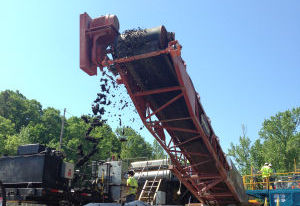Data shows migration of coal ash
By Taft Wireback(Greensboro, N.C.) News & Record | Posted: Friday, May 30, 2014 8:50 am
GREENSBORO, N.C. — Newly released data from federal researchers suggests that coal ash in the Dan River migrated fairly dramatically in recent weeks, but stayed well upstream from Kerr Reservoir
.
The U.S. Environmental Protection Agency released the data and a map late last week showing shifts in the percentages of coal ash in two sets of sediment samples, taken about a month apart at 29 sites along 70 miles of river spanning parts of North Carolina and Virginia.
The research shows diminishing percentages of coal ash near the retired Dan River Steam Station on the outskirts of Eden, and increasing levels near the downstream community of Danville, Va.
But the data and an EPA map based upon it are only part of the story from the Feb. 2 spill at Duke Energy’s former coal-fired plant, said Myles Bartos, an on-scene coordinator for the federal agency.
"The big message is that we’re not taking any action based only on what percentage the ash is," Bartos said. "We’re taking action based on where the metals are ... If the ash had no arsenic in it, it wouldn’t be a problem."
EPA teams will take another round of samples from the 29 sites starting within two weeks, then compare the river "model" that emerges against other sampling that tracked where suspiciously high levels of arsenic and selenium have been found, Bartos said.
Coal ash contains significant amounts of both those potentially harmful materials, posing possible threats to human health and the ecosystem.
The first two rounds of sediment tests suggest two important facts about the spill, Bartos said: The key drinking water lake, Kerr Reservoir, has emerged unscathed so far. And much of the contamination remains upstream from Danville, where a hydroelectric dam and the river’s natural features seem to have served as a brake.
"The good news is that it does not appear that there is anything that is in the lake," Bartos said of the reservoir that provides drinking water to communities in both states.
Experts found the most dramatic declines in ash percentages in samples near the Eden-area plant, where one site dropped from 66 percent to 2 percent coal ash, and another went from 56 percent to undetectable levels.
In all, coal ash percentages dropped or remained stable at 21 sites in the second round of tests. Coal ash was undetectable at 16 of those sites, and at eight of the nine closest to Kerr Reservoir more than 70 miles downstream from the spill.
Of the other eight, remaining sites where the percentage of coal ash increased during the month of testing, four were in or near Danville.
Under EPA supervision, Duke Energy began dredging up the largest deposit of coal ash from the spill about two weeks ago in that area, a 2,500-ton accumulation just upstream from the Schoolfield Dam.
EPA measurements along the Dan track what percentage of each sample is made up of coal ash, compared to normal river-bed material. Researchers began taking the first round of samples in early April and completed the second earlier this month.
They took samples from boats at roughly the same locations. Each site was selected based on the observations of various agencies participating in the cleanup, interviews with river guides and others familiar with the Dan, or advice from the U.S. Army Corps of Engineers, Bartos said.
Researchers drove specially designed tubes into the river bed at each site, then sent the resulting core samples to laboratories for detailed analysis, Bartos said. It is not an exact science, because it’s nearly impossible to find precisely the same spot in a river two or three times in a row, Bartos said.
Although researchers went deeper in some cases, the first six inches of sediment are the most critical, partly because that is the "active zone" sustaining most aquatic creatures that live in or near the riverbed, Bartos said.
A spokesman for the Southern Environmental Law Center in Chapel Hill said the data and map offer little solace.
"The coal ash is still in the river. A small amount has been dredged out to date, but most all of the coal ash is still in the river," said Frank Holleman, a senior attorney with the nonprofit law group that has battled Duke Energy on behalf of environmental groups concerned by its ash-handling techniques.
The ash stems from what’s left of coal burned to generate electricity. Some has been stored in ponds, often near streams and lakes.
"Coal ash does not evaporate or magically disappear. It will move around based on water movement, floods, rains, and disturbances," Holleman said. "It will move around and may not be in the same place in the same concentrations each time, but it’s in the river damaging the river."
Duke Energy spokesman Jeff Brooks said the new data indicate the spotty nature of the spill, that it did not "coat" the Dan with sludge in a continuous layer but settled here or there in deposits according to the river’s dynamics.
"Every additional sample gives us a better picture of where the coal ash has deposited and where it went," Brooks said. "That will help the (cleanup) team to better identify how to address river."
Duke is footing the bill to clean up the spill, which occurred after a drainage pipe ruptured beneath an ash pond at the retired plant. EPA is supervising the cleanup also involving environmental and other government agencies from both states.
"This monitoring is going to continue for many months," Brooks said.
http://www.godanriver.com/news/coal-ash/data-shows-migration-of-coal-ash/article_07b232a2-e7f9-11e3-b106-0017a43b2370.html




